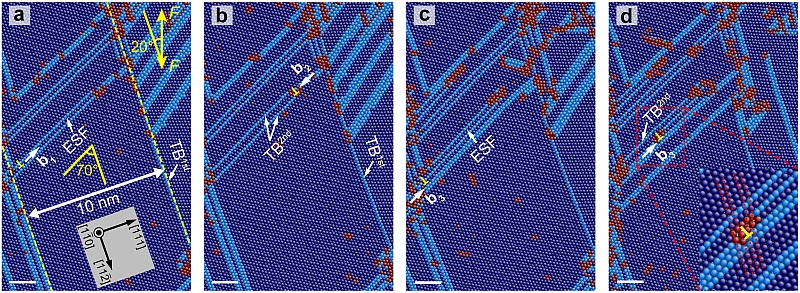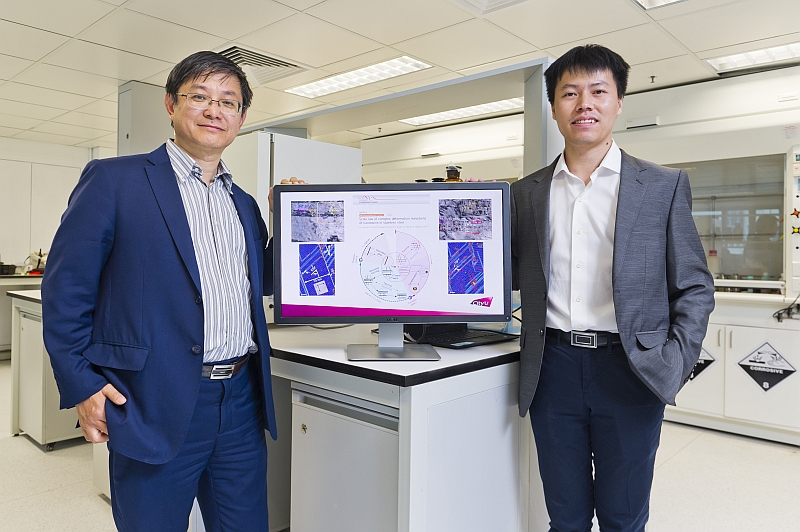Nanotwin deformation pattern in stainless steel revealed Paves the way to develop materials with higher strength and ductility

A research team comprising experts from City University of Hong Kong (CityU), the University of Shanghai for Science and Technology (USST) and Zhejiang University (ZJU) discovered for the first time the deformation transitions of multiscale nanotwins (NTs) in austenitic stainless steel, which will help develop materials with higher strength and ductility.
Their research results were recently published in the scientific journal Nature Communications, in an article titled “Scale law of complex deformation transitions of nanotwins in stainless steel”.
Most materials and alloys face the same dilemma: the higher the strength, the less the ductility and toughness, meaning that stronger alloys tend to fracture when deformed or stretched. However, the research team’s results have found that nanotwins, a kind of nano lamellar structure, enable materials to be strong and ductile. The higher the order of the hierarchical nanotwins, the higher the density of the nanotwins, and the higher the strength and ductility of the materials. Therefore, increasing nanotwin density via hierarchical twinning is an important means for materials scientists to develop novel materials that are both strong and ductile.
Led by Professor Lu Jian, CityU’s Vice-President (Research and Technology), the research team has discovered the marginal scale of nanotwin deformation transition mechanisms of austenitic stainless steel by combining in situ tensile tests with theoretical modelling and atomistic simulations.
Their discovery revealed that deformation mechanisms would be completely different when the twin-lamella spacing, meaning the spacing between nanotwins, is smaller than or equal to 5 nm, between 6 and 129 nm, and greater than 129 nm. When the spacing is smaller than or equal to 5nm, both primary twinning and detwinning (the disappearance of primary nanotwins) is activated. Spacing between 6 and 129 nm leads mainly to the occurrence of secondary twinning and an increase in the density of nanotwins.

“Nanotwins are a very important structure for materials with high strength and ductility. But they are not distributed throughout the materials, so we need to find ways to increase their density,” explained Professor Lu.
In recent years, materials scientists have done a lot of research on increasing the density of nanotwins from primary twinning. But increasing the density through activating secondary or higher order twinning of nanotwins has yet to be discovered. Also, most of the previous research focused on pure materials, such as pure copper or pure silver, instead of widely used engineering materials like stainless steel.
“We studied austenitic stainless steel because it’s a widely used engineering material,” Professor Lu said. Through many experiments and theoretical studies over the years, the research team established a deformation map of nanotwins, ranging from several nanometres to hundreds of nanometres in austenitic stainless steel, to show the deformation mechanisms of multiscale nanotwins. They also discuss in their paper the intrinsic mechanisms and transformation processes of nanotwins with varying scale effects.
“Our latest research discovery helps to find an optimization strategy of nanotwins for new engineering materials and new alloys. It serves as the basis for exploring a strengthening mechanism for other conventional metallic materials, and will help promote the design and development of advanced materials with nanotwins,” said Professor Lu.
Their next step is to find ways to achieve higher-order hierarchical twinning in stainless steel and other new materials, such as high-entropy alloys.
High-entropy alloys are new materials constructed with an equi-atomic or nearly equi-atomic percentage of five or more elements. They are currently a focus of attention in materials science and engineering because of their desirable properties for structural applications. According to a materials science research report compiled by the US National Academies of Sciences, Engineering and Medicine, titled Frontiers of Materials Research: A Decadal Survey (2019), classical metals and alloys, high-entropy alloys and nanostructured metallic alloys will have bright prospects in the next decade.
“Our research is fully aligned with the future direction of development for materials science,” said Professor Lu. “Stainless steel with nanotwins is both a classical alloy and a nanostructured alloy. Our latest research discovery not only optimises the performance of classical metals, but also enhances the characteristics of new materials, such as high-entropy alloys. The new alloy developed from high-entropy alloys (Science, Nov 2018) by Professor Liu Chain-tsuan, University Distinguished Professor at CityU, and the super strong magnesium alloy (Nature, May 2017) developed by my research team earlier are both good examples of CityU’s position in the frontier of materials science research in the world.”
The co-first authors of the paper are Dr Sun Ligang from CityU, Dr Chen Aiying from USST, and Dr Zhu Linlifrom ZJU, who are either current or previous members of Professor Lu’s research team at CityU. This research project was supported by the National Key Research and Development Programme of China and the General Programme of National Natural Science Foundation of China.
